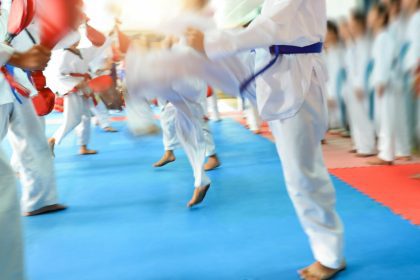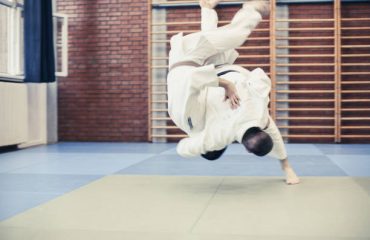
Brazilian Jiu-Jitsu (BJJ), a martial art known for its focus on grappling and ground fighting, has become increasingly popular among all age groups, including children. The path of a young BJJ practitioner is marked by progression through various Kids Jiu-Jitsu Belts, each representing a step forward in skill, discipline, and understanding of the art. This guide will explore the Kid’s Jiu-Jitsu Belt system, offering insights for parents and young martial artists alike. We’ll also look at how esteemed academies like Noco Jiu-Jitsu and Self-Defense incorporate this system into their youth programs, fostering a nurturing and empowering environment for young learners.
Introduction to Kids Jiu-Jitsu Belts
The belt system in Kids Jiu-Jitsu is not just a way to denote skill level; it’s a tool for teaching discipline, respect, perseverance, and goal setting. This path begins with the white belt and progresses through various stages until the black belt. Each belt color in the Kids Jiu-Jitsu system represents a new set of challenges and achievements, carefully designed to match the growing capabilities and understanding of young practitioners. It’s an adventure that goes beyond physical prowess, instilling in young learners the values of patience, hard work, and continuous improvement. These values are essential not only in Jiu-Jitsu but in all aspects of life.
Moreover, the structured approach of the Kid’s Jiu-Jitsu belts serves as a motivational tool. Children are naturally driven by a sense of accomplishment, and the belt system provides them with tangible goals to strive for. This aspect of the training is particularly emphasized in academies like Noco Jiu-Jitsu and Self-Defense, where each new belt is a celebration of the child’s commitment and progress. In addition to technical skills, instructors also focus on the development of social skills, such as teamwork, leadership, and empathy. These skills are nurtured through group drills, sparring sessions, and the communal environment of the dojo, making the progression through the Kid’s Jiu-Jitsu belts a holistic growth experience.
White Belt: The path of every young BJJ practitioner begins with the white belt. At this stage, the focus is on the fundamentals: basic techniques, learning to fall safely, and understanding the principles of leverage and control. It’s a time of new beginnings and setting the foundation for future growth.
During this initial phase, young athletes are introduced to the core values of Brazilian Jiu-Jitsu, such as respect, discipline, and perseverance. Instructors at academies like Noco Jiu-Jitsu and Self-Defense place special emphasis on creating an environment that is not only safe but also fun and engaging for children. This nurturing setting helps young practitioners develop a love for the sport, instilling a sense of achievement and enthusiasm as they master each new technique. White belt training is crucial as it lays the groundwork for all future learning in BJJ, building both physical skills and mental resilience that young students will carry with them throughout their martial arts experience.
Grey Belt: Unique to kids’ BJJ, the grey belt is the first step into the wider world of Jiu-Jitsu. Here, children start refining the basics and learning more complex techniques. It’s also a stage where the importance of sportsmanship and respect becomes more pronounced.
The grey belt marks an important transition period where young Brazilian Jiu-Jitsu students start preparing for more advanced training. At this stage, children have demonstrated competence in the basic techniques and principles. Now instructors can begin introducing additional concepts like chaining submissions together, dynamic movement, and increasing the speed of rolls during sparring sessions. Children are still focused on refining core techniques like maintaining proper posture and hip movement. But an expanded set of basic sweeps, escapes, guards, passes, and submissions give them a larger library of moves to attempt. Grey belts start to understand the underlying connections between techniques and positions as well. Demonstrating techniques with precision and control becomes a point of emphasis at this belt. Instructors also note the grey belt stage is pivotal for reinforcing respect, discipline, and sporting behavior. Children learn how etiquette in the dojo translates into positive traits outside of class as well. The grey belt sets the tone for the student’s continued progression to more advanced technical and strategic expertise.
Yellow Belt: As children progress to the yellow belt, their technical skills and sparring abilities are further honed. This belt level also emphasizes the importance of consistent practice and dedication. It’s a pivotal point where kids begin to understand the deeper aspects of BJJ, like strategy and adaptability.
Achieving the yellow belt represents an important milestone for young Brazilian Jiu-Jitsu practitioners. They have demonstrated consistency in attending classes and have acquired competency in the basic techniques. The additional technical and strategic knowledge yellow belts gain helps them apply moves more fluidly while sparring. Their understanding of concepts like establishing dominant positions, maintaining posture control, and chaining submissions together becomes more intuitive. Earning the yellow belt shows both the student and instructor that the fundamental building blocks of BJJ are now ingrained. This gives students increased confidence to continue on the lifelong path of skill development in the sport. With this enhanced base, yellow belts can begin exploring the nuances and finer details of techniques that are introduced in more advanced belt levels.
Orange Belt: Reaching the orange belt is a significant achievement in a child’s BJJ progression. Here, the focus shifts towards mastering more advanced techniques and starting to develop a personal style. At Noco Jiu-Jitsu and Self-Defense, this stage is marked by encouraging students to take on leadership roles and helping to mentor those in the earlier stages of their progression.
After demonstrating technical prowess in a wide range of basic BJJ moves and positions, the orange belt is awarded to students who are ready for more complex challenges. At this level, the emphasis starts transitioning from strict technique replication to tactically applying moves while rolling and sparring. Children develop keen insight into chaining techniques together in order to gain dominant positions and submit to opponents. An understanding of strategies related to top pressure, controlling space, grip fighting, and changing levels becomes ingrained during the orange belt level. This knowledge is then utilized to keep opponents off-balance while hunting for opportune moments to attack. Leadership also becomes a focus at this stage, as orange belts mentor their less experienced teammates, providing guidance and serving as role models within the gym. The mentorship role gives them interpersonal skills while reinforcing technical expertise as they coach others on proper execution. Earning the orange belt shows both proficiency in intermediate skills and a commitment to the positive culture that embodies the core tenets of Brazilian Jiu-Jitsu.
Green Belt: The green belt is the final stage before entering the adult belt system. This belt signifies a high level of proficiency and understanding of the art. It’s a testament to the hard work, discipline, and resilience the student has shown throughout their path.
Earning the green belt demonstrates that a student has deeply internalized the core concepts and techniques of Brazilian Jiu-Jitsu. They display technical mastery across a wide range of positions, seamlessly transitioning from one technique to the next against fully resisting opponents. Green belts have developed keen strategy and match tactics, leveraging their abilities to outmaneuver training partners. They anticipate reactions, set up intricate traps and combinations, and capitalize on small openings with precision. Kids at the green belt rank have gained significant mat time against a variety of opponents and styles. This allows them to remain calm under pressure when sparring, smoothly adapting their games mid-roll to counter their opponent’s strengths. Not only have they shown proficiency in advanced techniques, but green belts also exemplify the positive attitudes and leadership that reflect the core values of the art. As green belts prepare to enter the adult rankings, they have a deep base of skills and experiences that will serve as the foundation to achieve even higher levels of technical and strategic execution. Their path thus far has demonstrated admirable perseverance, discipline, and an unmatched passion for bettering themselves through this craft.
Training and Progression
Advancement through the Kids Jiu-Jitsu Belts at academies like Noco Jiu-Jitsu and Self-Defense is not solely based on technical skill. It also considers the child’s age, maturity, and the time spent at each belt level. This holistic approach ensures that children are not just skilled martial artists, but also responsible, respectful individuals.
The kid’s belt system is structured to gradually develop well-rounded students with a breadth of physical abilities, mental discipline, and positive character traits. Belt promotions evaluate more than just the number of techniques a child can execute. The additional factors of age-appropriate skill, time spent training, and maturity level ensure students have fully integrated each rank’s core concepts before progressing. Children might demonstrate the technical capabilities for the next belt level but need more time to mature and show consistency in applying those techniques against resistance. Patiently cementing these fundamental lessons develops grip strength and cardiovascular endurance as their bodies grow. Just as importantly, kids build trust with teammates and confidence within themselves by patiently putting in the mat time every level requires. Measuring progress in this holistic manner results in earned promotions that support students’ long-term development into skilled athletes and responsible members of the BJJ community.
The Role of Parents and Instructors
The passage through the Kids Jiu-Jitsu Belts is a collaborative effort involving instructors, parents, and the students themselves. Parents play a crucial role in supporting their children, providing encouragement, and fostering a positive attitude towards learning and improvement.
Parents are critical partners along every step of their child’s Brazilian Jiu-Jitsu path. From attending classes to cheer them on, helping them remember techniques at home, and emphasizing messages about respect and discipline, parents reinforce the lessons instilled in the academy. They celebrate small victories like learning a new submission hold just as enthusiastically as major milestones like belt promotions. This consistent encouragement motivates children to attend lessons, persevere through challenges, and continue progressing. Parents also model desired behaviors related to work ethic, goal setting, and maintaining a positive mentality when facing setbacks. Kids witness firsthand how applying these qualities leads to advancement. This lays the foundation for children to take ownership of their own development. With engaged parents guiding them, kids embrace the progressive path of BJJ belts not just as skill milestones, but as markers of personal maturity and accomplishment as well. The supportive home environment parents facilitate plays an immense role in breeding success.
Exploring the Kids Jiu-Jitsu Belts system is a rewarding experience that offers much more than just physical skills. It’s a path that shapes character, builds confidence, and teaches valuable life lessons. At Noco Jiu-Jitsu and Self-Defense, the path is tailored to ensure that each child not only becomes a skilled practitioner but also a well-rounded individual, ready to face life’s challenges with resilience and grace.




